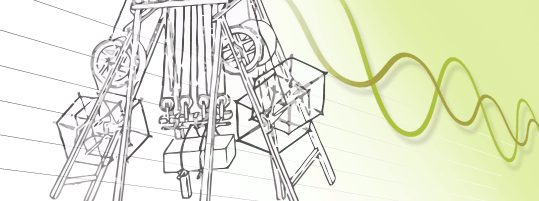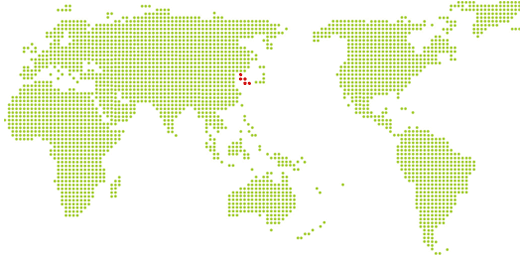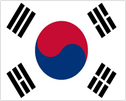
» Map of Korea

The Korean Peninsula is located in North-East Asia. It is bordered by the Amnok River (Yalu River) to the northwest, separating Korea from China,
and the Duman River (Tumen River) to the northeast which separates Korea from both China and Russia. The country itself is flanked by the Yellow Sea
to its west and the East Sea to the east. There are several notable islands that surround the peninsula including Jejudo, Ulleungdo and Dokdo.
The Korean peninsula is roughly 1,030 km (612 miles) long and 175 km (105 miles) wide at its narrowest point. Korea's total land area is 100,033 sq km,
and it has a population of 49.8 million people (2011).
Because of its unique geographical location, Korea is a very valuable piece of land and an international hub of Asia.
» Weather
Korea has four seasons, with a wet monsoon/summer season in the middle of the year, and a cold winter from November to March. The island of Jeju off the southern coast is the warmest and wettest place in the country. The ideal time to visit Korea is during the autumn months (September-November). During this time, the country experiences warm, sunny weather, skies that are cobalt blue and spectacular foliage that is perhaps the biggest draw. Winters are cold and dry and are a good time to visit if you are interested in winter sports as there are numerous ski resorts. Spring (April-May) is also beautiful with all the cherry blossoms in bloom. However, it is very busy and one needs to book in advance to ensure accommodation is available. The summer months are muggy and hot, and rather crowded. It is also when the monsoon season begins so many activities are subject to the fluctuations of heavy rain.
| Busan(1981-2000) | ||||||||||||
|---|---|---|---|---|---|---|---|---|---|---|---|---|
| Month | 1 | 2 | 3 | 4 | 5 | 6 | 7 | 8 | 9 | 10 | 11 | 12 |
| Average Temperature |
3.2 | 4.9 | 8.6 | 13.6 | 17.5 | 20.7 | 24.1 | 25.9 | 22.3 | 17.6 | 11.6 | 5.8 |
» The National Flag of Korea
 The Korean flag (태극기) is called "Taegeukgi" in Korean. Its design symbolizes the principles of the yin and yang in Oriental philosophy.
The circle in the center of the Korean flag is divided into two equal parts. The upper red section represents the proactive cosmic forces of the yang.
Conversely, the lower blue section represents the responsive cosmic forces of the yin. The two forces together embody the concepts of continual movement,
balance and harmony that characterize the sphere of infinity. The circle is surrounded by four trigrams, one in each corner.
Each trigram symbolizes one of the four universal elements: heaven, earth, fire, and water
The Korean flag (태극기) is called "Taegeukgi" in Korean. Its design symbolizes the principles of the yin and yang in Oriental philosophy.
The circle in the center of the Korean flag is divided into two equal parts. The upper red section represents the proactive cosmic forces of the yang.
Conversely, the lower blue section represents the responsive cosmic forces of the yin. The two forces together embody the concepts of continual movement,
balance and harmony that characterize the sphere of infinity. The circle is surrounded by four trigrams, one in each corner.
Each trigram symbolizes one of the four universal elements: heaven, earth, fire, and water
» Language of Korea
Hangeul (한글), Korea's official alphabet, was first invented by King Sejong during the Joseon Dynasty. Originally called Hunminjeongeum (훈민정음), the language was conceived in 1443, and further promulgated by the King in 1446. At the time of its inception, the language consisted of 17 consonants and 11 vowels however, since then, 3 of the originally established consonants and 1 vowel have fallen into disuse bringing the total number of characters to 24. Syllables are formed by the selective combination of vowels and consonants to create words.
| Consonants | |||||
|---|---|---|---|---|---|
| ㄱ | g,k | ㅂ | b,p | ㅋ | k |
| ㄴ | n | ㅅ | s | ㅌ | t |
| ㄷ | d,t | ㅇ | nq. silent | ㅍ | p |
| ㄹ | r,l | ㅈ | j | ㅎ | h |
| ㅁ | m | ㅊ | ch | ||
| Vowels | |||||
|---|---|---|---|---|---|
| ㅏ | a | ㅗ | o | ㅠ | yu |
| ㅑ | ya | ㅛ | yo | ㅡ | eu |
| ㅓ | eo | ㅜ | u | ㅣ | i |
| ㅕ | yeo | ||||
The official name for the Korean language was changed to 'Hangeul' in 1910. Hunminjeongeum Proclamation Day was called 'Gagya Proclamation Day' up until 1926,
and it wasn't until 1928 that it was changed to its current title, 'Hangeul Proclamation Day'.
The chart below represents the 24 Hangeul characters together with their romanized equivalents. 'The Hunminjeongeum,' a historical document which provides
instructions to educate people on the use of Hangeul, is registered with UNESCO. UNESCO awards a 'King Sejong Literacy Prize,' every year in memory of the inventor of Hangeul.
» Kimchi(Korean Food)

- Origin of Kimchi
For as long as humans have been cultivating they have enjoyed the nutritional elements of vegetables. However, the cold winter months, when cultivation
was practically impossible, soon led to the development of a storage method knowns as 'pickling'. Rich in vitamins and minerals, kimchi was conceived
in Korea around the 7th century.
- The Origin of the Name, Kimchi
It is suspected that the name kimchi originated from shimchae (salting of vegetable) which went through some phonetic changes: shimchae - dimchae - kimchae - kimchi.
- Reasons Why Kimchi Was Developed in Korea
Few fermented vegetable foods are found worldwide. Some possible reasons why kimchi was developed as a fermented food especially in Korea are as follows:
(1) vegetables were popular to the ancient people in Korea whose main industry was agriculture;
(2) Koreans had a remarkable technology for salting fish which was frequently used as a seasoning;
(3) cabbages (brassica) appropriate for making kimchi were widely grown.
- Modern Kimchi
Kimchi has been scientifically proven to be high in nutrition?and is often recommended as a valuable food source both at home and abroad. In fact, there has been
a significant increase in kimchi exports in recent years. Korean immigrants to China, Russia, Hawaii and Japan first introduced kimchi abroad, and have continued
to eat kimchi as a side dish. It gradually gained popularity even among foreigners. Accordingly, kimchi may be found wherever Koreans live. In America and Japan
especially, where relatively many Koreans live, packaged kimchi is easily available. In the past, the production and consumption of kimchi was confined to Korean
societies, however, in recent years it has become a globally recognized food.
















